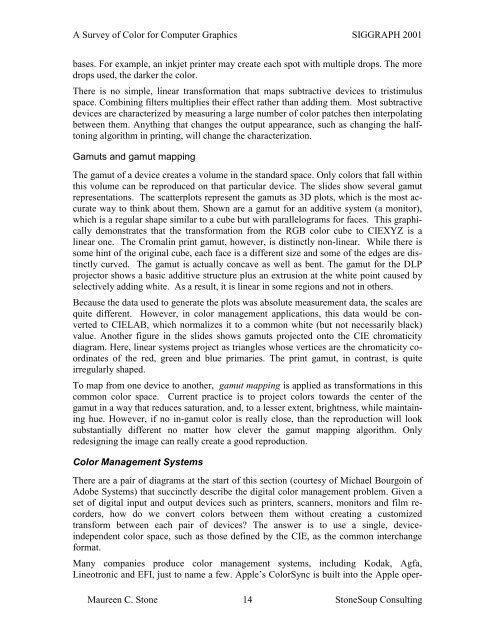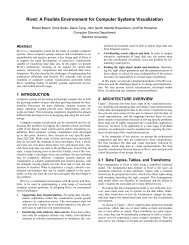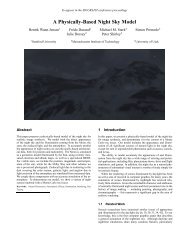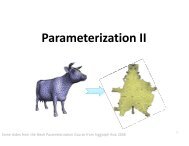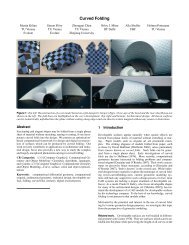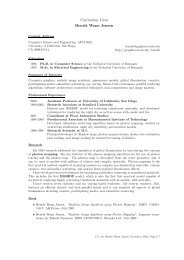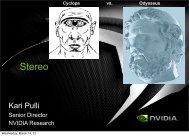A Survey of Color for Computer Graphics
A Survey of Color for Computer Graphics
A Survey of Color for Computer Graphics
Create successful ePaper yourself
Turn your PDF publications into a flip-book with our unique Google optimized e-Paper software.
A <strong>Survey</strong> <strong>of</strong> <strong>Color</strong> <strong>for</strong> <strong>Computer</strong> <strong>Graphics</strong> SIGGRAPH 2001<br />
bases. For example, an inkjet printer may create each spot with multiple drops. The more<br />
drops used, the darker the color.<br />
There is no simple, linear trans<strong>for</strong>mation that maps subtractive devices to tristimulus<br />
space. Combining filters multiplies their effect rather than adding them. Most subtractive<br />
devices are characterized by measuring a large number <strong>of</strong> color patches then interpolating<br />
between them. Anything that changes the output appearance, such as changing the halftoning<br />
algorithm in printing, will change the characterization.<br />
Gamuts and gamut mapping<br />
The gamut <strong>of</strong> a device creates a volume in the standard space. Only colors that fall within<br />
this volume can be reproduced on that particular device. The slides show several gamut<br />
representations. The scatterplots represent the gamuts as 3D plots, which is the most accurate<br />
way to think about them. Shown are a gamut <strong>for</strong> an additive system (a monitor),<br />
which is a regular shape similar to a cube but with parallelograms <strong>for</strong> faces. This graphically<br />
demonstrates that the trans<strong>for</strong>mation from the RGB color cube to CIEXYZ is a<br />
linear one. The Cromalin print gamut, however, is distinctly non-linear. While there is<br />
some hint <strong>of</strong> the original cube, each face is a different size and some <strong>of</strong> the edges are distinctly<br />
curved. The gamut is actually concave as well as bent. The gamut <strong>for</strong> the DLP<br />
projector shows a basic additive structure plus an extrusion at the white point caused by<br />
selectively adding white. As a result, it is linear in some regions and not in others.<br />
Because the data used to generate the plots was absolute measurement data, the scales are<br />
quite different. However, in color management applications, this data would be converted<br />
to CIELAB, which normalizes it to a common white (but not necessarily black)<br />
value. Another figure in the slides shows gamuts projected onto the CIE chromaticity<br />
diagram. Here, linear systems project as triangles whose vertices are the chromaticity coordinates<br />
<strong>of</strong> the red, green and blue primaries. The print gamut, in contrast, is quite<br />
irregularly shaped.<br />
To map from one device to another, gamut mapping is applied as trans<strong>for</strong>mations in this<br />
common color space. Current practice is to project colors towards the center <strong>of</strong> the<br />
gamut in a way that reduces saturation, and, to a lesser extent, brightness, while maintaining<br />
hue. However, if no in-gamut color is really close, than the reproduction will look<br />
substantially different no matter how clever the gamut mapping algorithm. Only<br />
redesigning the image can really create a good reproduction.<br />
<strong>Color</strong> Management Systems<br />
There are a pair <strong>of</strong> diagrams at the start <strong>of</strong> this section (courtesy <strong>of</strong> Michael Bourgoin <strong>of</strong><br />
Adobe Systems) that succinctly describe the digital color management problem. Given a<br />
set <strong>of</strong> digital input and output devices such as printers, scanners, monitors and film recorders,<br />
how do we convert colors between them without creating a customized<br />
trans<strong>for</strong>m between each pair <strong>of</strong> devices? The answer is to use a single, deviceindependent<br />
color space, such as those defined by the CIE, as the common interchange<br />
<strong>for</strong>mat.<br />
Many companies produce color management systems, including Kodak, Agfa,<br />
Lineotronic and EFI, just to name a few. Apple’s <strong>Color</strong>Sync is built into the Apple oper-<br />
Maureen C. Stone 14<br />
StoneSoup Consulting


